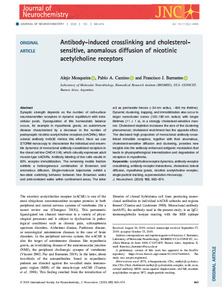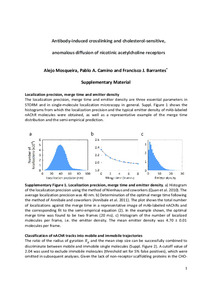Please use this identifier to cite or link to this item:
https://repositorio.uca.edu.ar/handle/123456789/14228| Título: | Antibody-induced crosslinking and cholesterol-sensitive, anomalous diffusion of nicotinic acetylcholine receptors | Autor: | Mosqueira, Alejo Camino, Pablo A. Barrantes, Francisco José |
Palabras clave: | MIASTENIA GRAVIS; ANTICUERPOS MONOCLONALES; COLESTEROL | Fecha de publicación: | 2020 | Editorial: | Wiley | Cita: | Mosqueira, A., Camino, P.A., Barrantes, F.J. Antibody-induced crosslinking and cholesterol-sensitive, anomalous diffusion of nicotinic acetylcholine receptors [en línea]. Journal of Neurochemistry. 2020, 152(6) doi:10.1111/jnc.14905 Disponible en: https://repositorio.uca.edu.ar/handle/123456789/14228 | Resumen: | Abstract: Synaptic strength depends on the number of cell-surface neurotransmitter receptors in dynamic equilibrium with intracellular pools. Dysregulation of this homeostatic balance occurs, for example in myasthenia gravis, an autoimmune disease characterized by a decrease in the number of postsynaptic nicotinic acetylcholine receptors (nAChRs). Monoclonal antibody mAb35 mimics this effect. Here we use STORM nanoscopy to characterize the individual and ensemble dynamics of monoclonal antibody-crosslinked receptors in the clonal cell line CHO-K1/A5, which robustly expresses adult muscle-type nAChRs. Antibody labeling of live cells results in 80% receptor immobilization. The remaining mobile fraction exhibits a heterogeneous combination of Brownian and anomalous diffusion. Single-molecule trajectories exhibit a two-state switching behavior between free Brownian walks and anticorrelated walks within confinement areas. The latter act as permeable fences (~34 nm radius, ~400 ms lifetime). Dynamic clustering, trapping, and immobilization also occur in larger nanocluster zones (120-180 nm radius) with longer lifetimes (11 ± 1 s), in a strongly cholesterol-sensitive manner. Cholesterol depletion increases the size of the clustering phenomenon; cholesterol enrichment has the opposite effect. The disclosed high proportion of monoclonal antibody-crosslinked immobile receptors, together with their anomalous, cholesterol-sensitive diffusion and clustering, provides new insights into the antibody-enhanced antigenic modulation that leads to physiopathological internalization and degradation of receptors in myasthenia. | URI: | https://repositorio.uca.edu.ar/handle/123456789/14228 | ISSN: | 1471-4159 | Disciplina: | MEDICINA | DOI: | 10.1111/jnc.14905 | Derechos: | Acceso abierto | Fuente: | Journal of Neurochemistry. 2020, 152(6) |
| Appears in Collections: | Artículos |
Files in This Item:
| File | Description | Size | Format | |
|---|---|---|---|---|
| antibody-induced.pdf | 838,9 kB | Adobe PDF |  View/Open | |
| jnc14905-sup-0001-figs1-s5.pdf | Material Suplementario | 694,13 kB | Adobe PDF |  View/Open |
Page view(s)
60
checked on Apr 27, 2024
Download(s)
151
checked on Apr 27, 2024
Google ScholarTM
Check
Altmetric
Altmetric
This item is licensed under a Creative Commons License

